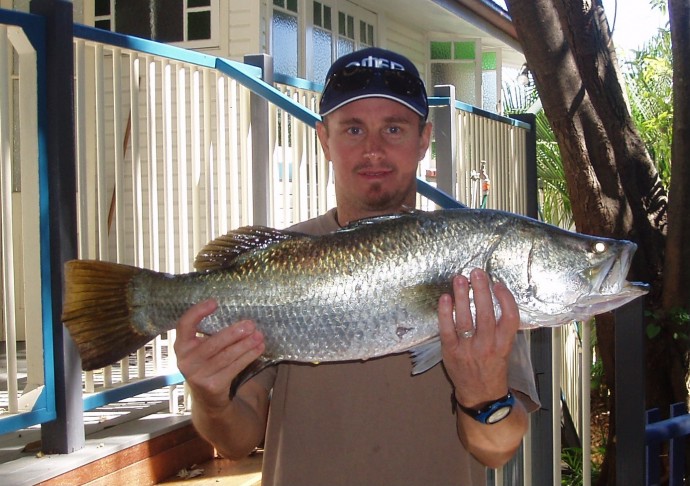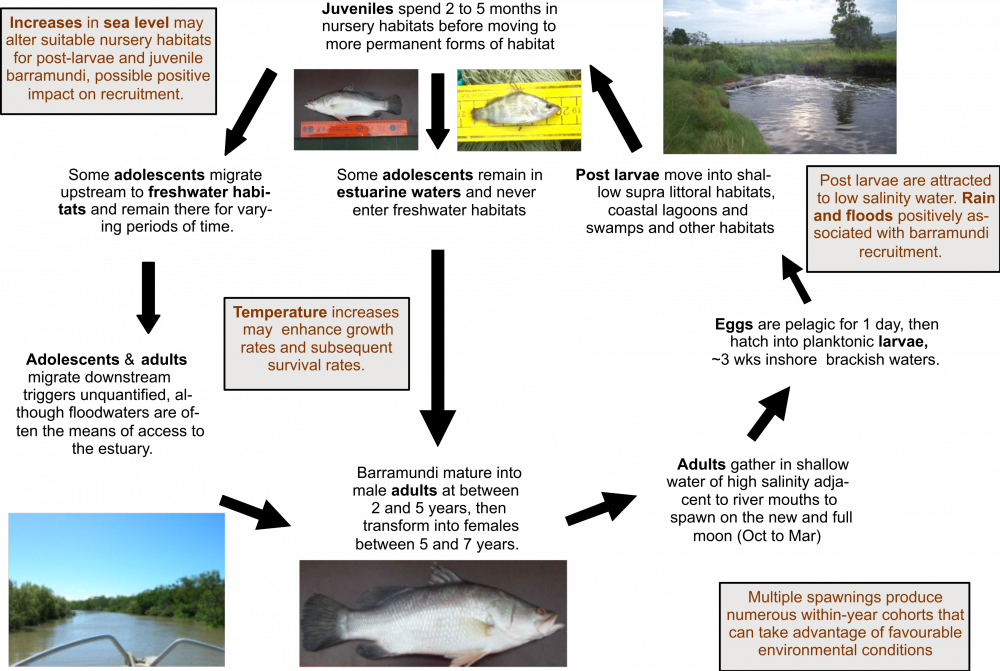Barramundi - Connections between the GBR and neighbouring regions
Introduction to Burramundi and why they are important
Barramundi is an iconic species throughout northern Australia and are important for all fishing sectors economically, socially and culturally. Catches of barramundi vary spatially and temporally and can be significantly related to river flow or rainfall (Robins et al. 2005; Balston 2009) and evaporation (Balston 2009). Variability in catch probably represents changes in underlying stock abundance linked to environmental drivers.
Barramundi (Lates calcarifer) are widely distributed throughout the tropical and sub-tropical waters of the Indo-Pacific region from the Arabian Gulf eastwards to China and Japan and southwards to Papua New Guinea and Australia (Pusey et al. 2004). They occur in a wide range of habitats including coastal foreshores, estuaries, tidal creeks, swamps, flood plains, coastal lagoons and upstream rivers where accessible from the sea (Lawson et al, 2014). On the Australian east coast barramundi occur in the Torres Strait and as far south as the Noosa River (26°30’ S) (Schipp 1996). Temperature appears to limit their southerly range limit and their relative abundance declines south of the GBRMP. Further, given the small coastal the relative abundance in the Torres Strait is also low.
Key concepts that relate to connectivity
Barramundi stocks in northern Australia are genetically different between the Gulf of Carpentaria and the Queensland east coast (Shaklee and Salini 1985; Salini and Shaklee 1988). Davis (1985, p189) suggests that because of localised spawning and genetic evidence of stock heterogeneity that “recruitment into major river systems would depend largely on the successful spawning of local populations” and that “the populations in different river systems may be quite independent of each other, and it may be appropriate to manage them as separate stocks”. Tagging studies have demonstrated that while barramundi can move large distances between estuaries, most individuals remain within a specified region (Lawson et al 2014).
The life cycle of barramundi is complex due to the use of multiple coastal habitats (Figure 3). A full detailed description on barramundi life history and fisheries is given in Lawson et al (2014).
References
Balston, J. (2009) Short-term climate variability and the commercial barramundi (Lates calcarifer) fishery of north-east Queensland, Australia. Marine and Freshwater Research 60, 912-923.
Davis, T.L.O. (1985). Seasonal changes in gonad maturity and abundance of larvae and early juveniles of barramundi Lates calcarifer (Bloch), in Van Dieman Gulf and the Gulf of Carpentaria. Australian Journal of Marine and Freshwater Research 36, 177-190.
Lawson, E., Saunders, T. and Robins, J. (2014) Barramundi (Lates calcarifer), In: Welch, D.J., J. Robins, and T. Saunders (editors) (2014) Implications of climate change impacts on fisheries resources of northern Australia. Part 2: Species profiles. Final report to Department of Agriculture, Fisheries and Forestry, and the Fisheries Research and Development Corporation, Canberra, Australia. https://docs.wixstatic.com/ugd/9d521f_3bdc7908b0b84f25a8a17caf74903dac.pdf
Pusey, B., Kennard, M., and Arthington, A. (2004). Freshwater Fishes of North-Eastern Australia. CSIRO Publishing Melbourne. 684 pps.
Robins, J.B., Halliday, I.A., Staunton-Smith, J., Mayer, D.G., and Sellin, M.J. (2005). Freshwater flow requirements of estuarine fisheries in tropical Australia: a review of the state of knowledge and application of a suggested approach. Marine and Freshwater Research 56, 343–360.
Salini, J. and Shaklee, J. B. (1988). Genetic structure of barramundi (Lates calcarifer) stocks from northern Australia. Australian Journal of Marine and Freshwater Research 39, 317-329.
Schipp, G. (1996) Barramundi farming in the Northern Territory. 1996 Edition. Department of Primary Industry and Fisheries, Darwin, N.T., 44 pp.
Shaklee, J.B. and Salini, J. (1985). Genetic variation and population subdivision in Australian barramudi, Lates calcarifer (Bloch). Australian Journal of Marine and Freshwater Research 36, 203-218.








